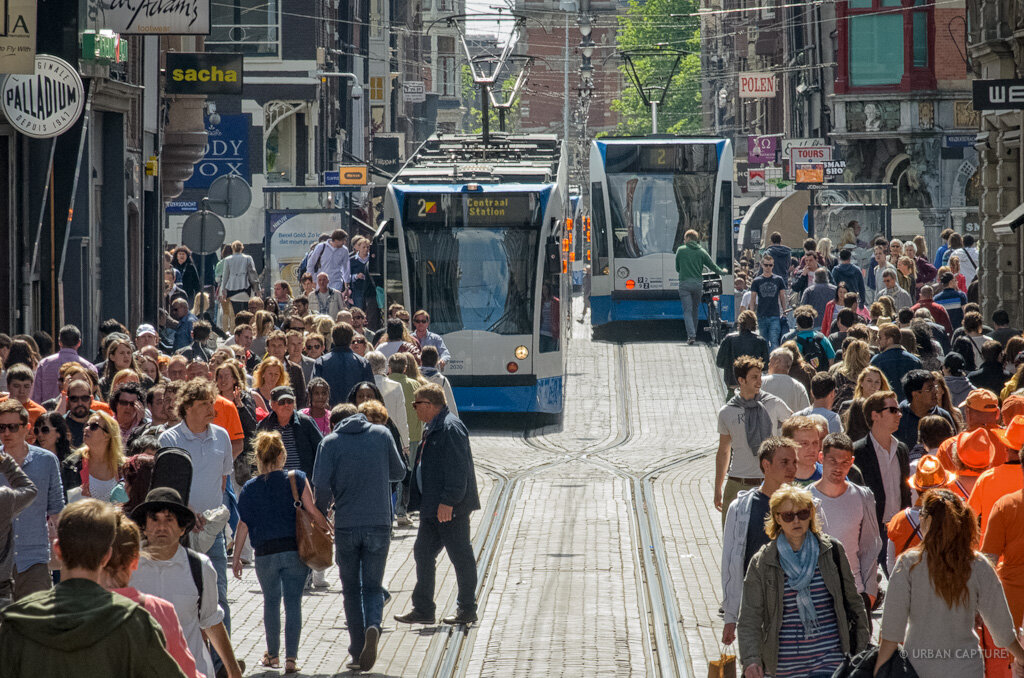
“Without a shared vision, every step is difficult, and every discussion becomes contentious. A vision inspires the community to be engaged in imagining and embracing change to shape its own future.” — Frank Palermo
Vision
Leading with transit is the right vision for NS, it has obvious, clear and immediate benefits that connect to our long term concerns. It touches on our aspirations and responds to the 5 most pressing needs of our time: climate change, health, equity, economy and growth.
We frequently hear that the solution to climate change is to realign our economy; that the answer to poverty is a guaranteed income; that the response to homelessness is to provide housing first; that to improve health we should stop polluting the environment and focus on preventative measures , like walking and biking; that economic development and growth depend on improving the quality of life. These prescriptions seen individually and together seem insurmountable, are often conflicting and frequently dismissed as unrealistic.
Leading with Transit is a bold initiative that addresses all these current needs that now require urgent attention. It touches all of our lives daily. It lifts prospects and connects communities. The vision is to invent Public Transit that will respond to climate change, advance social justice, improve housing affordability, enhance our health, drive our economy and prompt urban and rural growth. To accomplish this it can’t be an afterthought nor can it wait. It has to lead.
The Intersections of Transit and Society
Environment
The need for immediate and bold action on climate change is recognized in policies, plans, and funding initiatives at all levels of government. LWT will address climate change by dramatically reducing our dependence on the automobile, rethinking the relationship between home and work, reducing emissions, respecting our heritage, and seeing future development as respectful of our spectacular natural landscape (appendix 2).
Health, safety, and general welfare are the foundational principles that define the purpose of planning. There is significant evidence that current patterns of urbanization, prescribed ways of distributing land uses, and the lack of investment in appropriate infrastructure is adversely affecting our health.
LWT will make the air we breathe cleaner, make us more active, and create streets, neighbourhoods, hubs, and stations that are more walkable and provide better access to natural areas, recreation and healthy food (appendix 3).
Health
Equity
The need for affordable housing, poverty reduction measures, and equitable access to food, services, and sources of livelihood are urgent priority intentions at all levels of government. LWT will create more opportunities for affordable housing, provide better, more affordable access to services, work and recreation, and reduce individual transportation costs. LWT will make it possible, particularly for the most vulnerable populations (younger, older, lower income, and rural residents) to have direct and more independent access to healthcare, education, employment, friends, and opportunities (appendix 4).
There is a clear need to reduce transportation costs for the individual. Meanwhile, the cost of maintaining and extending current infrastructure is not sustainable. Many studies have indicated that, in the new economy, jobs follow people. Business is mobile, the quality of life in Nova Scotia is important, and housing and cost of living is more affordable here. It is clear that high quality public and active transportation is a missing ingredient, essential to attracting and keeping business and people here (appendix 5).
Economy
As articulated in various municipal plans and studies of rural Nova Scotia, there is a need for growth. The problem is that we currently have very little control over where it happens or what form it takes. Nor are we able to ask new development to meaningfully contribute to a larger vision or local infrastructure improvements.
LWT will determine where growth and development happens. It will affect the form that it takes, reduce infrastructure costs, and integrate land use. Transit, in conjunction with high speed internet, will encourage appropriate growth in the right places throughout Nova Scotia and reverse the continued rural population decline. LWT will make it possible for smaller communities throughout Nova Scotia to grow. LWT will also spur population and business growth as it improves quality of life and links urban residents to a wealth of extraordinary amenities and destinations around the province (appendix 6-ref. Ivany Report- quote) (appendix 6).
Growth
Why here? Why now?
This is the right moment. Cities need to change now to urgently respond to our five most pressing needs (Environment, Health, Equity, Economy and Growth) and enormous technological advances that open previously inconceivable opportunities.
The digital age connects us in new ways, alters the relationship between home and work, and lessens our dependence on the automobile. Technology has allowed us to re-imagine public space, reconsider how we grow, and invent new patterns of urbanization. Standing still is not an option. Change needs to happen now before continued undirected growth compromises future options including the effectiveness of transit. Nova Scotia is the right place to lead with transit.
Fortuitously, we did not invest too heavily in extensive highway systems in the last century. The centre and the suburbs of our cities and towns are not defined by highways, traffic jams, long commutes, or endless sprawl. Consequently, given our scale, we can do what many other places cannot realistically contemplate. This is our opportunity to become a model for post-industrial urban and rural communities that are environmentally responsible, healthy, equitable, economically vibrant, and growing.
To be effective, transit needs to be the first choice and the best option to get from place to place. It needs to encompass a long-term view and set ambitious targets. It needs to connect core suburban and rural areas and extend to the rest of the province. It is essential, permanent infrastructure that must come first. Transit leads, then growth will follow.
This project extends, implements, connects, and builds on the work of private, public, and third sector that exist or are currently underway at the municipal, provincial, and regional levels, including:
The Ivany Report
Sustainable Transportation Strategy
The work of Engage Nova Scotia
Develop NS and the Rural Transit Committee
Queens Country Transit Study
Local Rural Community Transit initiative
HRM Integrated Mobility Plan
Moving forward Together Plan
It’s More than Buses
Smart City and Innovation District initiatives
The Downtown Plan
The Centre Plan
Regional plan review process
Initiatives of the Provincial Department of Energy including Nova Scotia
“If you don’t know where you are going, any road will take you there” —George Harrison
What distinguishes LWT is not only that it cuts across urban, rural and jurisdictional boundaries; not simply that it is based on a long term view of growth and the need for immediate change; not only that transit has to be integrated with land use and can serve as an instrument to determine where and how growth happens (as opposed to chasing it); nor is it just about setting high targets to make a difference— what is most important is that the initiative comes from and is directed by the community (appendix 7 ref. PDC and Cities by Design). The obstacle to real change is not the lack of money, the routine urgency of daily life, or wavering, time sensitive political support. These obstacles, both real and imagined, are overcome everyday by the most powerful force for change: an aware, committed, and inspired community that understands the need for change and is engaged in imagining and shaping its own long-term future.
Building the Idea
`
Through a number of community meetings over the last two years, this idea has been tested and developed.
A. Seven principles have been identified, which can be considered performance standards (appendix 8).
Frequent + Reliable + Efficient + Permanent + Accessible + Passenger-centric + Placemaking
B. These principles lead to the conclusion that the transit system is Light Rail Transit (LRT) on a designated right-of-way. The concept is that Light Rail Transit provides a skeleton around which urban stations, suburban centres, and rural and small-town hubs are built (appendix 9).
C. LWT means fewer cars, less on-street parking, and more room for walking, biking, and life on the street. LWT is the key to placemaking (see appendix 10).
D. The system connects the whole province. It extends from the core of HRM in series of fingers through the suburban areas. The fingers generally follow main streets that define and protect natural areas with lakes, green areas, and drainage courses. Four of the fingers extend beyond the suburbs to the rural limits of HRM and beyond that to the North Shore, the Valley, South-West Nova Scotia, the South Shore, the Eastern Shore, and Cape Breton (appendix 11).
The background work carried out to date serves to reinforce the feasibility, potential, and urgency of LWT. The intent of this proposal is to build on that momentum. Our purpose is to develop from the bottom up, in collaboration with Municipal and Provincial governments, a plan which includes vision, feasibility and action toward the largest and most important public infrastructure project in Nova Scotia’s history.
Description and Approach
ENGAGEMENT
Community members of urban and rural, young and old, must be aware of the idea, its importance, and the dramatic effect that it will have on them, their community, and the province. The public must also be involved in imagining, developing, and figuring out how to make the LWT project happen. LWT will focus on involving youth in particular. LWT will only happen if it has wide and strong public support. LWT must belong to the community.
PILOT
The intent is to build community engagement by demonstrating and testing how LWT will work on the ground. Communities throughout the province (with school engagement) will be challenged to imagine and invent local transit feeder services to regional hubs or stations. Six projects (one in each area) will receive funding to implement the idea. Findings from the pilots will inform the work on the Investment and Concept pieces of the LWT project.
INVESTMENT
There is a need to see LWT as an investment we can’t afford not to make. In terms of:
A. Identifying and documenting social, environmental and economic benefits- to the individual and to the community.
B. Describing costs, possible sources of funding, how it will operate and why we need to start immediately
CONCEPT
The concept needs to be developed to illustrate how it works and what it looks like as a system and on the ground for residents in urban, suburban and rural areas. The intent then is to incorporate LWT into the vision for the Province and all Municipalities and begin work to make LWT happen on the ground. (We will refer to these four aspects as EPIC: Engagement, Pilot, Investment, Concept)
Leading with Transit divides the province up into six areas to more effectively empower and engage communities.
Each aspect needs to be carefully considered and developed on its own and will produce specific outcomes. Each aspect is also dependent on all other aspects and must be developed simultaneously.
Extending LWT Across Nova Scotia The project covers all of Nova Scotia.
This is not only ambitious, but essential to thinking of the province as a whole. Given the scale and scope of the project and the importance of local community engagement, the proposal divides the province into six areas: SOUTH shore, NORTH shore, EAST shore, WEST valley, CAPE Breton, and Halifax Regional Municipality.
In each of the six areas, an “Area Team” will be established, each consisting of approximately 12 members.
Progress on all four Aspects of the project will happen within communities in all six areas of the Province. Each area will have four Aspect Leaders – one for each Aspect: engagement, pilot, investment, concept (EPIC). The leaders for each Aspect will also work together as a team, with their counterparts in each of the other six Areas (SNEWCH). Those four teams of six people will be responsible for ensuring consistency, coordination, and resource sharing across the province as well as ensuring that local interests, knowledge, and values are respected.
Support staff will consist of four to five people working under a coordinator and will be responsible for research, mapping, case studies, reporting, capacity building, visualization, managing experts’ participation in workshops, and round table discussions across all four Aspects of the project in all six areas. The director, administrative staff, and the four Aspect Leaders constitute the Project Team.
The Concept
While all aspects (Engagement, Pilot, Investment, Concept) are interrelated, the Concept is critical in pulling everything together. It amalgamates ideas from the other three Aspects. Steps 2 to 6 (described above) effectively summarize the work required to produce a concept plan for LWT more specifically those steps should be understood to include:
Consolidate | Illustrate | Principles | Ideas | Vision
Background
Existing population, distribution (people) patterns of:
Residential
Work/ employment
Commercial services
Health • Education
Recreation
History/ cultural assets
Potential and existing constraints related to land:
Environmentally sustainable features
Historically big assets
Topography
Current infrastructure (settlement) access, mobility, services
Existing ROW’s
Trails, walking and biking
Rail lines, used and unused
Logging roads
Concept Development
Potential development growth areas
Case studies
LWT alignment concept and possible hub locations
Connections to break services
DESIGN DEVELOPMENT
Urban and rural
Establish principles
Illustrate/ develop service/ visually model/ the line/ route/ alignment
Placemaking
Hubs, stations, steps
STRATEGY
Implementation and connection (described and visualized)
Develop conceptually an operational strategy for LWT (case studies)
Integrate/connect LWT to Municipal and Provincial plans and policies
Develop strategy for retaining public benefit from increased development potential (and reduced parking requirement)
Develop land use policies and development guidelines for TOD along LWT lines, hubs, and stations
REPORT AND PLAN To serve as:
The vision, which is broadly, known, understood and supported across the province
The investment (business) case for doing it (cost/ benefit)
The basis to apply for Infrastructure Canada funding

















